The Leading Edge: June 2023 Wind Energy Newsletter
In this edition, we discuss offshore wind energy potential in the Great Lakes, hear from next-generation postdocs studying the effect of wind on solar power, remember a mother-to-all colleague, introduce new offshore wind flow modeling projects, and more.
News Stories
Exploring Offshore Wind Energy Opportunities in the Great Lakes
The potential amount of offshore wind energy in the Great Lakes region of the United States could be substantial, according to a new National Renewable Energy Laboratory (NREL) report. More than enough, in fact, to accommodate the electricity consumption of most nearby states. This opportunity could enable states in the region to achieve their clean energy goals, boost their economies with high-paying jobs, and provide a cleaner environment for residents. But the lakes’ freshwater environment poses different challenges from those faced by ocean-based offshore wind energy development. Freshwater ice, for example, is stronger than sea ice, meaning that more robust offshore wind turbines, mooring and cable systems, and other structures will be required. In the report, NREL researchers identify other key issues, in addition to freshwater ice, that need to be tackled for this potential to be realized and define a comprehensive research program to address these challenges. With that considered, they outline a commercial pathway for Great Lakes wind energy that could begin before 2035.
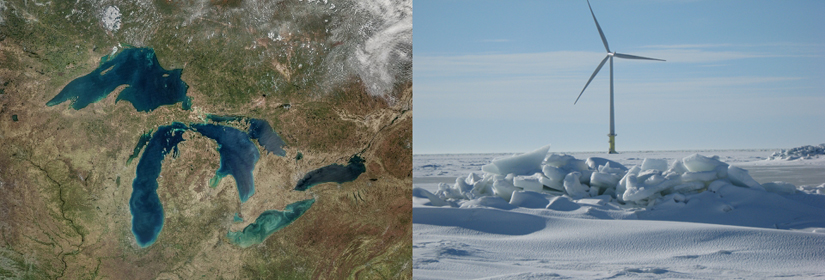
NREL Postdoctoral Researchers Study Turbulent Winds To Boost Concentrating Solar Efficiency
Meet three NREL wind energy postdoctoral researchers who are investigating the impact of turbulent wind conditions on concentrating solar power (CSP) structures and performance. Ulrike Egerer's passion for flight evolved into a career dedicated to fighting climate change; now she analyzes wind measurements to discern how wind affects CSP collector structures. Stephanie Redfern compares observed wind data with weather model outputs to enhance wind forecasting at CSP plants and is preparing to pivot to a career in medicine. Brooke Stanislawski uses computer modeling to assess the performance of CSP plants based on the orientation of solar collectors. Their findings will help the CSP community not only predict the impact of turbulent wind conditions but also develop solutions for more resilient CSP facilities. Read their spotlight to find out how these researchers are combining their powers to improve the efficiency and decrease the costs of solar power, learn about their passions beyond the lab, and get a glimpse of their visions for a greener future.
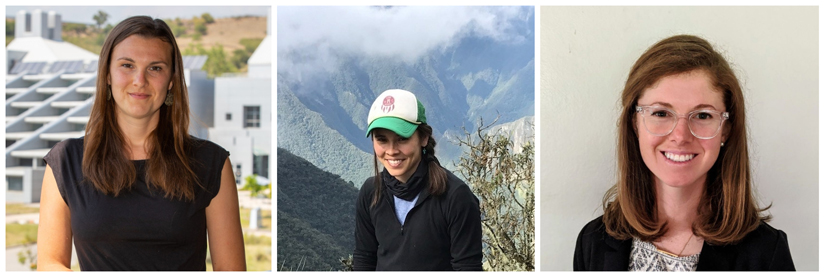
Behind the Blades
Remembering Dorothy Haldeman, Former Wind Energy Administrator and Mother to All
She laughed with her whole body, and once she started, she couldn't stop. She took pride in her Finnish heritage. And she loved her teammates.
Dorothy Haldeman, who died recently at 92, is remembered fondly by her former NREL colleagues. From 1997 to her retirement in 2011, she provided administrative support at NREL's National Wind Technology Center (or NWTC, based at what is now known as the Flatirons Campus).
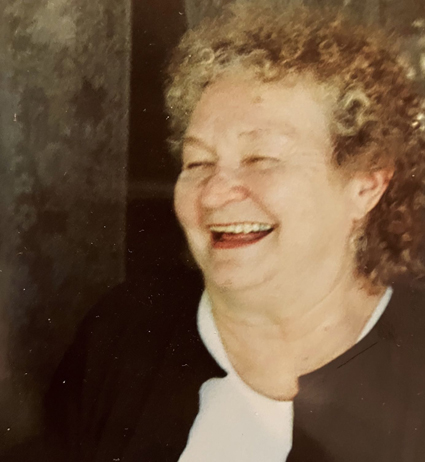
"My favorite memory was just her cackle of a laugh that you could hear from far away and how she loved to tell stories of her kids and grandkids. She was always super friendly to people," recalled Patrick Moriarty, an NREL wind energy group manager.
Mother to All
That was Mary Wheeler's favorite thing about Haldeman, how she laughed a lot—and with her whole body.
"She was like a second mother or grandmother to many, and she was a dear friend to all," said Wheeler, an NREL research project manager who worked with Haldeman for 10 years.
Donna Heimiller, acting group manager for NREL's Geospatial Data Science group in the Strategic Energy Analysis Center, started at the NWTC as an intern in 1998. She said Haldeman made her feel right at home. "Dorothy was so warm and funny. She was one of the people who made the NWTC and NREL feel like a family to me by being everyone's forthright grandma," Heimiller said.
Haldeman's boss, NREL Researcher Emeritus Bob Thresher, said she was a great employee who would pitch in to help everyone. "Dorothy wanted to help. She was very good natured and looked after people—she kind of mothered them, including me," Thresher said.
Thresher said he and Haldeman had a good relationship. They were both "Yoopers" from the Michigan Upper Peninsula, and she would kid Thresher about getting his undergraduate degree from Michigan Tech in the Upper Peninsula, where they called it "Da Tech" instead of Michigan Tech.
Brian Smith, who joined NREL in 1988 and now serves as the wind energy laboratory program manager, remembered, "She was a kind and gentle soul who loved her Wind Weenies at the National Wind Technology Center."
Balancing the Wind Weenies
"Wind weenies," with "weenies" meaning nerds, was a slang term used to describe people working on and developing wind turbines in the 1990s, when wind energy was just beginning to become reliable and cost-effective. Staff at the NWTC adopted the name for themselves and, every year during the holidays, organized a singing group called the "Wind Weenie Wailers." The group wrote spoof lyrics for well-known holiday songs, which they performed during NWTC holiday celebrations. Haldeman contributed her voice to the comedic choir for years.
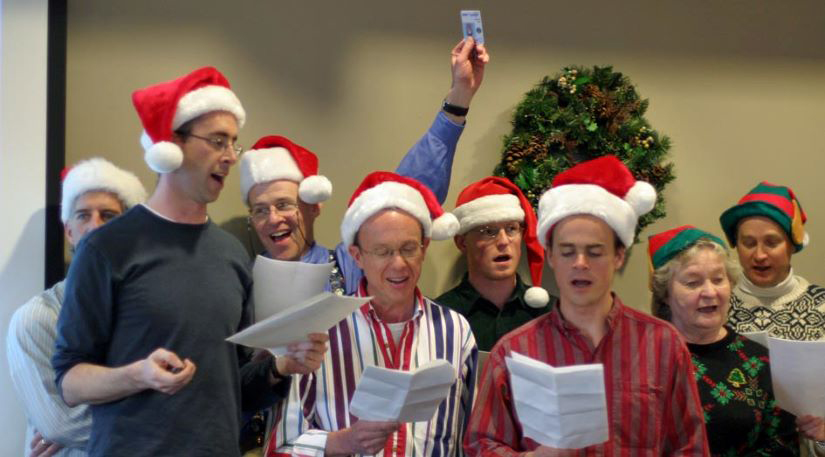
"Dorothy was always a willing member of the Wailers and one of our only female members of the group, which were sparse at the time so highly valued to balance out the machismo," said Moriarty, who became the Wind Weenie Wailers director and songwriter in 2002. While the group hasn't been active since the pandemic, Moriarty is planning a comeback this year.
Haldeman had a unique role in helping the few women who worked at the NWTC in the early 2000s. "She made us laugh and made sure we took care of ourselves when things were stressful in the office. She would remind us of the important things in life—like spending time with our parents and kids or enjoying the sunshine," said Suzanne Tegen, a former NREL employee. "We should all strive to be a bit more like Dorothy."
Friendly to the Finnish
Haldeman had other vocal skills. Proud of her Finnish heritage, she spoke fluent Finnish. "Dorothy lit up when she could speak to Finnish wind energy colleagues in her native language," said Smith.
Her skills came in handy when she and Trudy Forsyth, a former employee who was NREL's small wind turbine program lead when she worked with Haldeman, traveled together to the Midwest Renewable Energy Fair held annually outside Stevens Point, Wisconsin. There they answered questions and handed out wind energy information.
"Dorothy could talk with the farmers who showed up to learn about wind energy. She knew about the local values, polka dancing, pasties, lutefisk, and other Finnish delicacies. These farmers started to come every year to talk with Dorothy about wind or the challenges of their lives, and she was able to open their eyes to the possibilities of wind energy," Forsyth said. "The last year I went to this event, Dorothy was not with me and there were a number of disappointed folks."
When Haldeman retired, the Wind Weenies pooled funds to send her and her daughter to Finland to visit relatives. She loved her family and loved to travel.
"My magic memory moment of Dorothy was to see her and her daughter, DonnaLea, after they returned from their first-ever visit to Finland," Smith said. "Dorothy never thought she'd have the chance to visit her homeland and was giggly upon return. She and DonnaLea were bursting with appreciation of the Wind Weenies who helped make a lifelong dream come true."
On the Radar
With Instrument Setup Complete, Experiments Begin on Texas Wind Turbine
Deployment activities for the Rotor Aerodynamics, Aeroelastics, and Wake experiment have ended after researchers completed several trips to install instruments to collect detailed measurements on a 2.8-MW wind turbine in Lubbock, Texas. In the coming months, researchers will move forward with subcampaigns that intentionally push the turbine into complex operational states and shut downs, providing valuable new data. The even flow of atmospheric and wind turbine response measurements will allow the team to begin a hierarchy of model validation activities to ensure that computer simulations of wind turbine behavior are accurate for large, land-based wind turbines. The 3-year collaboration among NREL, Sandia National Laboratories, and GE Renewable Energy aims to build a comprehensive and unique data set, which could improve wind turbine simulation capabilities.
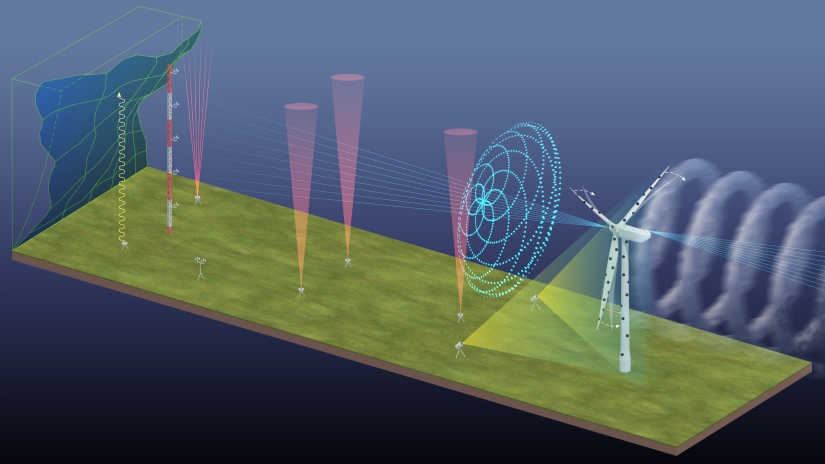
Offshore Wind and Weather Modeling Projects Come to Successful Conclusions
Researchers at NREL developed robust strategies for connecting regional-scale weather information with wind power plant-scale turbulent flow simulations through the Offshore Wind Atmospheric Coupling (OWAC) and Mesoscale-Microscale Coupling (MMC) projects. Wind data from a regional-scale weather model can now be fed into a high-resolution turbulent simulation, which uses turbulence-triggering coupling methods. This coupling vastly increases the realism and range of weather conditions under which users can simulate plantwide wind flow. The projects culminated with a symposium hosted by the OWAC/MMC team and the Wind Energy Science journal article Lessons Learned in Coupling Atmospheric Models Across Scales for Onshore and Offshore Wind Energy. Findings are now informing new projects that would not be possible without the OWAC/MMC research.
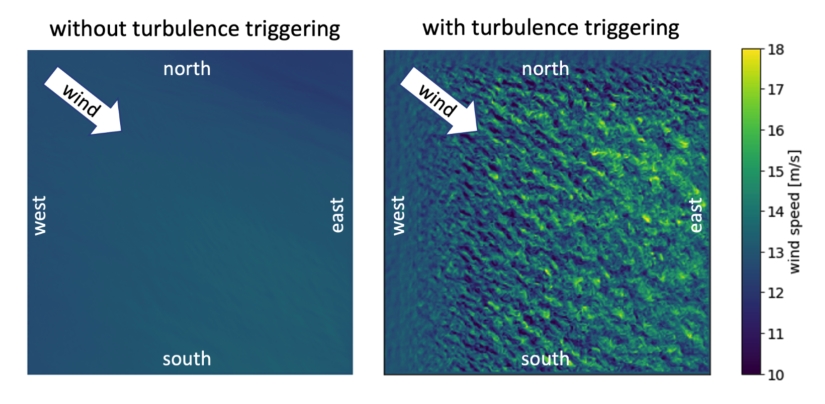
A bird’s-eye view of the computed wind speed 100 meters above the ocean surface (at typical offshore wind turbine heights) shows that simulations without a turbulence-triggering mechanism (left) produce an unrealistically nonturbulent wind flow compared to those with (right) turbulence triggering which produces realistic turbulent winds. Accurately capturing the turbulence in the winds is paramount in estimating wind turbine fatigue and overall wind plant power. Image by Regis Thedin, NREL
Informed by Recent Findings, New Offshore Wind and Weather Modeling Projects Kick Off
As the nation develops plans to deploy offshore wind farms, understanding operational and extreme wind conditions along U.S. coastlines is crucial. NREL researchers launched two new projects to further these understandings: the Observational driven Resource Assessment with CoupLEd models (ORACLE) project and the TRopical and EXtropical cyclone impacts on Offshore wind energy (TREXO) project.
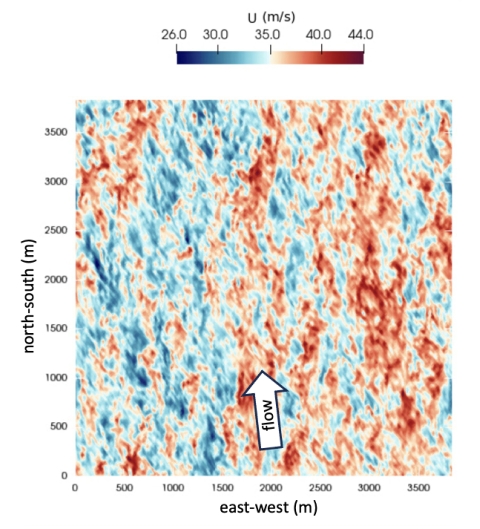
To study the effects of weather on offshore wind energy, both projects draw on the experience and knowledge gained from the MMC and OWAC projects and apply them to U.S. Pacific Coast wind flow and U.S. Atlantic Coast hurricane wind flow in ORACLE and TREXO, respectively. Specifically, in the ORACLE project, researchers will explore the complex interaction between the ocean surface and winds blowing at wind turbine heights. They will also study the impact of clouds on the turbulence experienced by wind turbines, which could inform designs to improve their durability and efficiency.
In the TREXO project, researchers aim to assess the risks of hurricanes to Atlantic wind energy projects, requiring detailed modeling of the winds within hurricanes. That project will help assess hurricane damage risk to wind-energy projects in regions of the U.S. Atlantic Coast, assess mechanical loads experience by wind turbines and their substructures in different parts and strengths of hurricanes, and assist turbine manufacturers and operators in devising and testing wind-turbine hurricane survival strategies.
Downwind: In Case You Missed It
Collegiate Wind Competition Leads to Clean Energy Careers
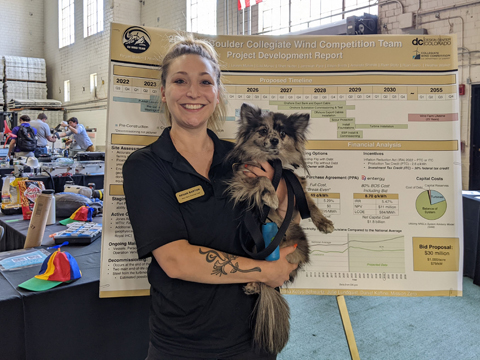
Regan Barton, pictured here with her service-dog-in-training Tillman, represented the University of Colorado Boulder at the Collegiate Wind Competition 2023 final event. Now, with a degree in environmental engineering and her team’s awards for second place overall and first in the Bonus Siting Challenge under her belt, Barton will soon embark on a full-time job as a siting engineer with Westwood Professional Services. Photo by Tara McMurtry, NREL
College students from across the nation gathered in May 2023 to showcase their wind energy innovations at the 10th annual Collegiate Wind Competition final event in Boulder, Colorado. Managed by NREL, this competition prepares college students for jobs in the renewable energy workforce through real-world experience with wind energy. NREL caught up with Regan Barton, a Collegiate Wind Competition alumnus, to learn about her post-competition career path and how she's applying lessons learned from the competition to her career in renewable energy.
Upcoming Events and Opportunities
Join NREL and the U.S. Department of Energy Wind Energy Technologies Office at upcoming events. Below are a few highlights.
Synthesis of Environmental Effects Research Offshore Wind Energy Webinar
July 6, 2023, Online
The U.S. Offshore Wind Synthesis of Environmental Effects Research project is hosting a webinar titled Recent Advances in Autonomous Environmental Monitoring Technologies to Support Offshore Wind Energy Development on July 6, 2023. Register for the webinar via Zoom.
NAWEA/WindTech 2023 Conference
Oct. 30–Nov. 1, 2023, Denver, Colorado
The NAWEA/WindTech 2023 Conference is taking place at the Omni Interlocken Hotel in Colorado in the fall. The event will feature presentations and posters in more than 20 scientific tracks and offers workshops, meetings, and a graduate student symposium Nov. 2–3, 2023. Book your lodging from the conference site.
NREL in the News
Reaching for the Sky: The Race To Develop High Altitude Wind Power Technology, Energy Portal, June 16, 2023
Powering Change: Critical Trends in the Global Energy Landscape, Sherine Ibrahim, Energy Central, June 9, 2023
DMCI Power To Put Up Wind Power Plant in Semirara Island, Jon Viktor D. Cabuenas, GMA Integrated News, June 5, 2023
Superlab 2.0 To Test U.S. Electricity Grid's Resilience to Possible Disruptions, Jijo Malayil, Interesting Engineering, June 3, 2023
Career Moves: U.S. Offshore Wind Powering Up, Tom Ewing, Marine Link, May 31, 2023
Recent Publications
Analysis
Assessing the Impact of Cybersecurity Attacks on Energy Systems, Applied Energy (2023)
Insensitivity to Propagation Timing in a Preview-Enabled Wind Turbine Control Experiment, Frontiers in Mechanical Engineering (2023)
On the Interaction of a Wind Turbine Wake with a Conventionally Neutral Atmospheric Boundary Layer, International Journal of Heat and Fluid Flow (2023)
Energy Potential
Long-Term Uncertainty Quantification in Weather Research and Forecasting Modeled Offshore Wind Resource Off the U.S. Atlantic Coast, Wind Energy Science (2023)
Wind Resource Data for Southeast Asia Using a Hybrid Numerical Weather Prediction with Machine Learning Super Resolution Approach, NREL Technical Report (2023)
Want More?
Subscribe to The Leading Edge newsletter, and explore the latest news and accomplishments in wind energy at NREL.
Share

